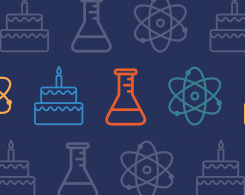Today in Science Blog Posts

Happy Birthday, Osborne Reynolds
Osborne Reynolds was an Irish physicist whose work focused on mathematics, thermodynamics, and — most notably — fluid mechanics.

Celebrating the Life of Robert Hooke
Robert Hooke was a Renaissance-era scientist who developed a law of elasticity (now called Hooke’s law) and published a well-known textbook on microscopy.

Happy Birthday, Wilhelm Röntgen
Wilhelm Röntgen, a German physicist, is best known for discovering X-rays. Fun fact: The first X-ray ever taken is of the hand of his wife, Anna Bertha.

Happy Birthday, Galileo Galilei
Galileo Galilei was a renowned astronomer who changed the way we think about mathematics, physics, and astronomy.

Investigating Whale Behavior with an Innovative Tagging Device
Using a durable tracking device, marine biologists and oceanographic researchers can enhance their understanding of whale behavior and investigate ocean conditions.

Happy Birthday, Albert A. Michelson
Did you know that Albert A. Michelson, inventor of the Michelson interferometer, was the first person to accurately measure the diameter of a distant star near the Sun?

Why Is Ice Slippery Enough for Skiing and Skating?
The original theory for why ice is slippery involves the concept of pressure melting. However, the true answer involves more research, debate, and thought.

Happy Birthday, Marie Curie
Did you know that Marie Curie coined the word “radioactive”? We discuss the life, work, and accolades of this Nobel Prize-winning scientist.

Soft Robotics Enables Flexible Robot Designs to Take Shape
Fun fact: Insects and ocean-dwelling creatures often inspire researchers’ soft robot designs. Read about 3 examples here.

Celebrating the Life of Leon Theremin
The theremin is the first portable electronic instrument to be mass produced. It is also the only instrument that can be played without being touched. Learn about its inventor here.

Producing Safe Drinking Water with a Novel Nanoparticle Biofoam
Nanoparticle biofoam could be a cost-effective, easy method to purify water, which could help with the major global initiative to provide an efficient method for generating safe drinking water.

Stretchable Electronics Blend Flexibility with High Performance
See how stretchable electronics are successfully blending strength and flexibility to offer new opportunities for technological growth in the wearables and internet of things (IoT) markets.

Happy Birthday, Dorothy Crowfoot Hodgkin
Dorothy Crowfoot Hodgkin was an English scientist whose research greatly advanced the field of X-ray crystallography. Learn more about the life and work of this Nobel Prize-winning scientist.

Metal-Foam Material Prompts New Shape-Shifting Technology
Engineers at Cornell University designed a hybrid material that can shift in shape, bringing new developments to the fields of soft robotics and aeronautics in the process. Get the full story.

Mildred Dresselhaus, a Driving Force for Women in STEM
Learn about the life and work of American scientist Mildred Dresselhaus, a driving figure in getting more women involved in science and engineering.

Explaining the Pepper’s Ghost Illusion with Ray Optics
Pepper’s Ghost, the famous optical illusion used in theater and “hologram” concert performances, can be explained using ray optics. Learn more and see our homemade Pepper’s Ghost projector.

Happy Birthday, Clinton Davisson
Clinton Davisson is best known for his discovery of electron diffraction through the Davisson–Germer experiment. Learn more about the life and work of this American physicist >>

Studying Salt Damage to the World’s Crumbling Buildings
We sometimes hear of tourists getting into trouble for carving their initials into the walls of the Coliseum in Rome and other famous structures. However, the more serious damage to this architecture is caused by something else entirely — salt. Transported by wind and water droplets, and even found in some building materials, salt is a powerful mineral that can cause a building’s façade to crumble and break. Researchers studied this effect to better predict salt’s behavior and prevent damage.

Happy Birthday, Erwin Schrödinger
We discuss the life and work of the legendary physicist behind Schrödinger’s cat, the Schrödinger equation, and more: Erwin Schrödinger.

Using an Origami Battery to Power a Biosensor
Researchers from the University of Binghamton developed a paper-based battery using an origami folding technique to transform 2D sheets of paper into a 3D battery structure.

Happy Birthday, Nicolas Léonard Sadi Carnot
Known as the “father of thermodynamics”, Nicolas Léonard Sadi Carnot developed a theoretical thermodynamic cycle and laid the groundwork for the second law of thermodynamics.

Exploring the Natural Strength of Limpet Teeth
Fun fact: Spider silk used to be considered the strongest natural material in the world. That is, until researchers from the University of Portsmouth identified a new winner: limpet teeth.

Happy Birthday, Gustav Kirchhoff
Gustav Kirchhoff is known for his contributions to the study of spectroscopy, electrical circuits, and thermochemistry. Learn more about the German physicist here.

In the Spotlight: Conserving and Restoring Art with Light
Did you know that 2015 is known as the Year of Light? Further, light can be used to conserve and restore historic paintings and artwork. Learn more in this blog post.
